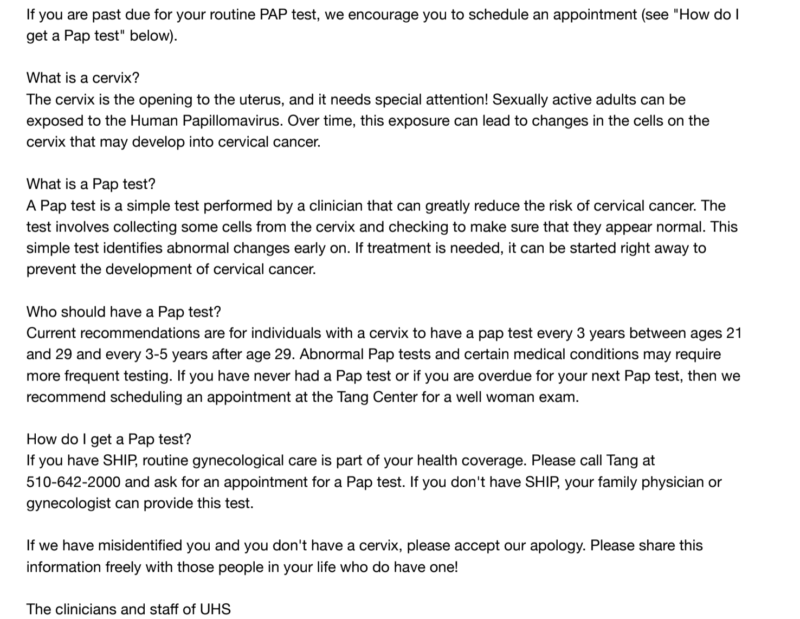Attention Cervix-Havers Of California!

The University of California’s medical
staff reaches out to the Cervix-Havers in their community:


“Individuals with a cervix.” You know, women. Those using this crackhead locution are not activists; they are medical professionals. But I guess you can’t tell the difference anymore. But wait, they speak in the letter of a “well woman exam.” Bigots! They mean a “well cervix-haver exam.” Now the clinicians and staff of UHS have made the whole campus an unsafe space. They’re basically the Taliban.
Along those lines, a Cervix-Having reader who is tired of this kind of misogynistic derangement writes to say:
At some point in the midst of my first pregnancy, all the official medical and government websites switched from “pregnant mothers” to “pregnant people” and from “nursing mothers” to “lactating people.” This is ridiculous. And it is offensive. I consider myself a deeply religious person [not a Christian], but becoming a mother has been the single most transformative experience of my life. The impact it has had on my relationship to my body, my femininity, my womanhood is profound. I refuse to pretend that this is a gender-neutral experience, and I am offended that it is now routine, considered enlightened even, to suggest as much. And although the physicality of motherhood may be different for adoptive mothers, I would expect they feel the same. It is past time for women to stand up and protest the erasure of our experiences, the theft of our private spaces, the attack on our achievements—not to mention the multifaceted assault on our daughters that the new gender ideology represents. (According to Abigail Shrier’s book (p. 62), schools are now describing women like Joan of Arc and Catherine the Great as “gender non-conforming.” What happened to “strong women”? I guess only [trans-]men can accomplish great things?) If that makes me a TERF, so be it.
UPDATE: A physician writes:
I had a tragic case in which a trans (female to male) patient had been on testosterone for many years. Not only did this suppress her menstrual cycle and grow a beard (desired effects) but it also manifested her genetic predisposition for male pattern baldness (probably not the look desired). Tragically, it also suppressed bleeding from her endometrial cancer (as you know, almost always the presenting symptom for that) so that she presented with incurable metastatic cancer. Did the cavalier grab-the-helm hormone therapy cause, accelerate, and mask her terminal cancer? Almost certainly. You can imagine that it’s pretty much impossible to even get case reports of this sort of thing published because it flies in the face of the party line that “there is no evidence that gender-affirming therapies are associated with an increased risk of malignancies.” From the oracles at UC San Francisco:
https://transcare.ucsf.edu/guidelines/ovarian-cancer
https://transcare.ucsf.edu/guidelines/masculinizing-therapy
https://transcare.ucsf.edu/guidelines/physical-examinationQuote from the last on physical examination:
The pelvic exam may be a traumatic and anxiety inducing procedure for transgender men and other trans-masculine persons. Transgender men are less likely to be up to date on cervical cancer screenings [5] and have a higher rate of inadequate cytologic sampling.[6] It is essential to make clear to the laboratory that the sample being provided is indeed a cervical pap smear (especially if the listed gender marker is “male”) to avoid the sample being run incorrectly as an anal pap, or discarded. The use of testosterone or presence of amenorrhea should be indicated on the requisition.
Should the individual express distress or concern about the examination, it may be deferred until a later date once a trusting relationship has been developed. A website with further details on pelvic examinations and screening can be found at checkitoutguys.ca (link is external).[7] Various techniques can be used to make a pelvic examination (including bimanual and/or speculum exam) less uncomfortable.
Subscribe for as little as $5/mo to start commenting on Rod’s blog.